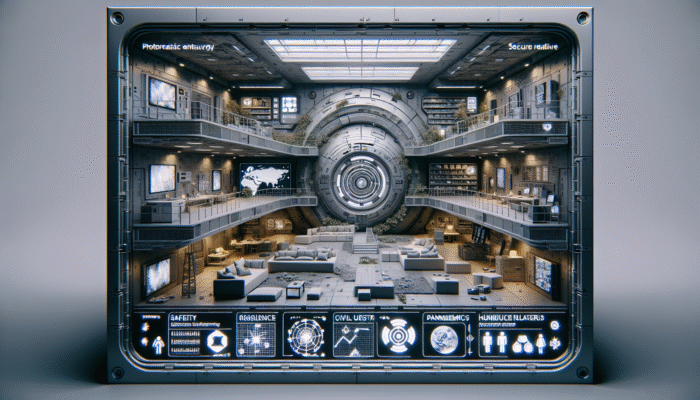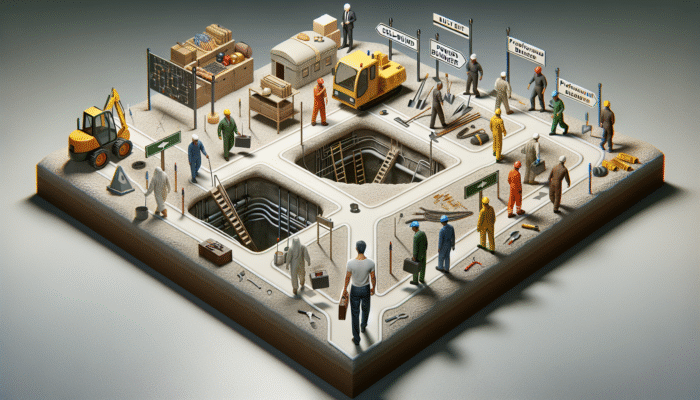S.H.I.T Bunker: Your Essential English Outline Guide
Creating Your Ultimate Survival Shelter: Key Considerations for a S.H.I.T Bunker
When considering the concept of survival, the idea of creating a S.H.I.T bunker stands out as an essential element. This secure refuge acts as a crucial resource, offering safety and reassurance during chaotic situations. Recognizing the importance of a bunker empowers you to take proactive steps and effectively prepare for unexpected emergencies.
Understanding the Importance of a S.H.I.T Bunker

The significance of building a S.H.I.T bunker cannot be emphasized enough. In a world that is increasingly filled with unpredictability, threats like natural disasters, civil unrest, and pandemics can disrupt everyday life without any warning. A well-designed bunker provides a safe haven where you and your loved ones can seek refuge, ensuring protection and survival in dire situations. With a thoughtfully constructed bunker, you not only shield yourself from physical threats but also mitigate the psychological effects that crises can cause. By preparing ahead of time, you build resilience, allowing you to confront challenges with assurance.
In addition, a bunker fosters a sense of self-sufficiency. It equips you with the necessary tools and resources to endure adversities—both literal and metaphorical. Ultimately, the process of building a S.H.I.T bunker represents an investment in your future, establishing a dependable foundation from which to navigate life’s uncertainties.
Selecting the Optimal Location for Your Bunker
Choosing the right site for your bunker is vital to its overall effectiveness and safety. The ideal location should provide discretion, away from the sight of onlookers, while still being accessible for you and your family in times of crisis. Factors such as proximity to essential resources, natural barriers, and geographical stability will greatly influence your decision.
Begin by analyzing the natural landscape. Flat, elevated terrain is generally the most favorable, as it minimizes flooding risks and simplifies construction. Look for areas with abundant vegetation, which can offer natural camouflage and additional protection. Furthermore, being close to fresh water sources is crucial, guaranteeing access to clean drinking water during prolonged stays in your bunker.
It’s also necessary to investigate local zoning laws and regulations. In various regions, building a bunker might necessitate permits or compliance with specific building codes. Familiarizing yourself with these legal requirements before commencing construction can save you considerable time and effort in the future.
Critical Supplies to Stockpile in Your Bunker
When preparing to build a S.H.I.T bunker, gathering the right supplies is of utmost importance. A well-equipped bunker should cater to both immediate and long-term survival needs. Begin with food provisions. Non-perishable staples such as canned goods, freeze-dried meals, and bulk grains should form the core of your food supply. Aim to include a range of items that encompass proteins, carbohydrates, and essential vitamins.
Equally important is water storage. Your bunker should ideally accommodate at least one gallon of water per person per day, stored in durable, food-grade containers. Additionally, invest in a reliable water purification system to ensure that you can safely access clean water from nearby sources.
Don’t overlook the importance of first aid supplies. A well-stocked first aid kit must include bandages, antiseptics, pain relievers, and any necessary prescription medications. Emergency tools such as flashlights, batteries, and multi-tools should also be prioritized.
Lastly, consider comfort. Incorporate items like sleeping bags, blankets, and entertainment options to help maintain morale during extended periods of confinement. The ultimate aim is to create a self-sufficient environment that meets all your fundamental needs.
Designing Your S.H.I.T Bunker: Essential Construction Insights

The process of designing and constructing your S.H.I.T bunker demands meticulous planning and execution. The structure must be secure, functional, and capable of withstanding various threats. Understanding fundamental design principles can help guide you in creating a bunker that meets these criteria.
Core Design Principles for Your Bunker
As you embark on the journey of building a S.H.I.T bunker, adhering to fundamental design principles is crucial. First, prioritize structural integrity. The bunker should be fortified to withstand external forces, whether they arise from natural disasters or potential intruders. A robustly constructed bunker typically utilizes a combination of concrete and steel to achieve maximum strength and durability.
Another principle that must be considered is ventilation. Adequate airflow is essential to maintaining a livable environment within your bunker. Incorporate a dependable ventilation system that allows for fresh air circulation while preventing contaminants from entering. Installing air filters can further improve air quality, ensuring a healthy atmosphere inside.
Additionally, prioritize accessibility. The design should enable easy movement within the bunker, accommodating all necessary supplies and equipment. Consider establishing designated zones for sleeping, eating, and storage, which can help maintain organization and efficiency during emergencies.
Choosing the Right Materials for Bunker Construction
The materials you select for building a S.H.I.T bunker play a vital role in its effectiveness and durability. Begin with the structural components. Reinforced concrete is a widely favored choice due to its strength and ability to endure extreme conditions. It offers excellent insulation and can withstand substantial pressure, making it ideal for underground bunkers.
Steel is another essential material, particularly for doors and critical structural supports. High-quality steel can provide an additional layer of security, deterring unauthorized access. Beyond these primary materials, consider insulation. Proper insulation will help regulate temperature, keeping the bunker comfortable regardless of external weather fluctuations.
Waterproofing materials should also be incorporated. Moisture can lead to mold and structural damage over time, so using water-resistant membranes can safeguard your investment. Lastly, don’t overlook the importance of finishing materials. Opt for options that are easy to clean and maintain, ensuring your bunker remains functional even during prolonged use.
Weighing DIY Construction Against Professional Services

As you plan your S.H.I.T bunker, one significant decision you’ll encounter is whether to pursue the project yourself or hire professionals. Each approach has its distinct advantages and drawbacks.
Opting for a DIY route provides greater control over the design and associated costs. You can customize every element of the bunker to suit your specific requirements and preferences. Moreover, the hands-on experience can be empowering, equipping you with valuable skills that may be beneficial for future projects. However, this route demands a considerable time commitment and a solid grasp of construction techniques.
Conversely, hiring professionals can expedite the construction process and ensure that the bunker complies with all safety standards and regulations. Experienced builders can efficiently navigate complex construction challenges, potentially saving you both time and money in the long run. However, this option may prove to be more costly, and you might have less control over design choices.
Ultimately, the decision should align with your budget, skill level, and the urgency of your bunker needs. Evaluating these factors will assist you in determining the most suitable path forward in your bunker-building journey.
Implementing Advanced Survival Strategies in Your S.H.I.T Bunker
Once your S.H.I.T bunker is constructed, mastering advanced survival techniques is essential for maximizing its potential. These skills can enhance your self-sufficiency and ensure you are prepared for any situation that may arise.
Effective Water Purification Techniques
Access to clean water is a cornerstone of survival; thus, effective water purification methods are vital in your bunker. While storing bottled water is important, having a reliable purification system ensures you can safely source water from local supplies.
One efficient method involves using filtration systems that incorporate activated carbon and reverse osmosis. These systems effectively eliminate contaminants, providing safe drinking water. Additionally, consider integrating UV light purifiers, which can eradicate viruses and bacteria without employing chemicals.
Boiling water is another straightforward and highly effective purification method. Simply bringing water to a rolling boil for at least one minute can eliminate most pathogens, making it a reliable option in emergencies. Keep a portable stove or heat source in your bunker to facilitate this process.
Finally, always have chemical purifiers readily available. Water purification tablets can serve as a practical backup, offering a simple solution in scenarios where other methods are impractical. By adopting a multi-faceted approach to water purification, you can ensure a consistent supply of safe drinking water within your bunker.
Strategies for Food Storage and Preservation
Food storage is critical in your S.H.I.T bunker, ensuring access to nutritious sustenance during extended stays. The key to effective food preservation lies in understanding various storage techniques and selecting appropriate food types.
Begin by prioritizing non-perishable items. Canned goods, dehydrated meals, and freeze-dried foods are excellent long-term storage options. These items generally have extended shelf lives and retain their nutritional value when stored correctly. Regularly rotating your supplies is essential to maintain freshness.
Next, consider vacuum sealing as a preservation technique. This method removes air from food packaging, dramatically slowing spoilage. You can vacuum seal items like grains, nuts, and even certain meats to prolong their shelf life.
Additionally, familiarize yourself with fermenting and pickling as alternative preservation techniques. These methods not only extend the longevity of your food but also introduce beneficial probiotics that promote gut health. Integrating a variety of preservation methods into your bunker’s food supply helps ensure a balanced diet during challenging times.
Establishing Emergency Communication Systems
Staying connected during emergencies is crucial, making the establishment of effective communication systems within your S.H.I.T bunker essential. Without reliable communication, you risk isolation and lack vital information that could influence your survival.
First, consider investing in a radio communication system. A two-way radio can maintain your connection with others outside your bunker, allowing you to receive updates and coordinate plans. Ensure you have backup power sources, such as solar chargers or batteries, to keep your communication devices operational.
Additionally, explore the use of satellite phones. Unlike traditional cellular networks, satellite phones can function in remote areas without cellular coverage. This capability can prove invaluable during widespread emergencies when conventional communication systems may be compromised.
Finally, develop a communication plan with your family and community. Establish protocols for checking in with one another and sharing vital information. This proactive approach can enhance your overall preparedness, ensuring you are ready for whatever challenges may arise.
Navigating Legal and Ethical Aspects of Building a S.H.I.T Bunker
As you embark on the journey of building a S.H.I.T bunker, it is crucial to understand the legal and ethical landscape surrounding bunker ownership. Navigating these considerations can help you avoid potential pitfalls and promote responsible preparedness.
Familiarizing Yourself with Local Regulations
Before beginning construction on your S.H.I.T bunker, it’s essential to familiarize yourself with local regulations and zoning laws. Each region has its unique set of rules governing the construction of underground structures, and failing to comply can result in fines or forced demolition.
Start by contacting your local building authority to inquire about the required permits for bunker construction. In some areas, you may need to submit plans for approval before breaking ground. Understanding these regulations can save you time and resources, ensuring your bunker is built legally.
Moreover, consider the environmental impact of your bunker. Some regions have strict regulations regarding land use and environmental conservation. Be mindful of your location’s ecosystem and adhere to guidelines that protect natural resources.
By obtaining the necessary permits and complying with legal requirements, you establish a solid foundation for your bunker project, facilitating a smooth construction process and long-term viability.
Examining the Ethical Implications of Bunker Ownership
Owning a bunker raises ethical considerations that transcend mere survival. Reflecting on the moral implications of preparing for emergencies can promote a more responsible approach to your preparedness efforts.
One vital aspect is the notion of community resilience. While having a personal bunker may provide individual security, it’s essential to consider how your preparedness affects your neighbors and the community as a whole. Engaging in community preparedness initiatives can enhance collective safety and foster a spirit of cooperation.
Additionally, reflect on the potential for resource hoarding during crises. Owning a bunker might lead to the temptation to excessively stockpile supplies, which can create scarcity for others in your community. Strive for a balanced approach, ensuring that you have adequate resources while also being considerate of the needs of those around you.
Ultimately, adopting a holistic perspective on bunker ownership can lead to a more thoughtful and ethical approach to survival preparedness.
Integrating Your Bunker into Community Preparedness Plans
Integrating your S.H.I.T bunker into broader community emergency plans is vital for fostering a resilient neighborhood. Collaborative efforts can enhance preparedness and ensure that everyone is equipped to face challenges together.
Start by engaging with local emergency management agencies. These organizations often have established protocols for community preparedness and can provide valuable resources and guidance. Collaborating with them can strengthen your bunker’s role within the larger emergency response framework.
Additionally, consider forming or joining local preparedness groups. These groups can facilitate knowledge-sharing and resource pooling, allowing community members to support one another during crises. Participating in drills and training sessions can enhance your skills and fortify community bonds.
Furthermore, advocate for local initiatives that promote emergency preparedness education. By raising awareness and providing resources to your neighbors, you contribute to a culture of preparedness that can benefit everyone. In this way, your bunker becomes not just a personal refuge but a crucial component of a collective safety network.
Ongoing Maintenance and Upkeep of Your S.H.I.T Bunker
Once your S.H.I.T bunker is completed, ongoing maintenance and upkeep are essential to ensure its longevity and functionality. Regular attention to your bunker will protect your investment and enhance its readiness for emergencies.
Conducting Regular Maintenance Inspections
Establishing a routine for regular maintenance checks is crucial for the durability of your S.H.I.T bunker. Start by developing a comprehensive checklist that includes inspections of structural integrity, ventilation systems, and water supply lines.
Examine the walls and ceiling for any signs of cracks or leaks that could compromise the bunker’s security. Addressing these issues promptly can prevent more extensive damage in the future. Also, check the ventilation system to ensure it operates effectively, providing fresh air while filtering out contaminants.
Water supply lines should be inspected regularly. Look for signs of leaks or blockages that could impede your access to clean water. Consider setting seasonal checks to ensure that everything remains in working order.
By remaining proactive with maintenance, you can detect potential problems early and take corrective measures, ensuring your bunker remains a reliable sanctuary in times of need.
Keeping Your Bunker Supplies Updated
Maintaining a well-stocked bunker requires regular updates to your supplies. Given that food and medical supplies have expiration dates, it’s crucial to rotate items and replace them as necessary to ensure freshness.
Conduct an inventory of your supplies at least every six months. This process will enable you to identify expired items and plan for replacements. Use the FIFO (First In, First Out) method to ensure you consume older items first, minimizing waste.
In addition to food and medical supplies, consider updating your equipment as technology advances. For instance, newer water purification systems or communication devices may offer enhanced functionality and reliability. Keeping informed about advancements in survival gear will ensure your bunker remains equipped with the best resources available.
Regularly updating your bunker supplies not only preserves your readiness but also boosts your confidence in your ability to navigate emergencies successfully.
Enhancing Security in Your Bunker
Security is a critical concern for any S.H.I.T bunker. Implementing effective security systems can safeguard your bunker against unauthorized access and ensure your safety during crises.
Begin with physical security measures, such as reinforced doors and secure locking mechanisms. Installing a heavy-duty door with high-quality locks can deter intruders and provide peace of mind. Additionally, consider adding deadbolts or security bars for an added layer of protection.
Next, explore advanced security technologies. Surveillance cameras and motion detectors can offer real-time monitoring of your bunker’s perimeter. These systems can alert you to any potential threats, allowing you to respond proactively.
Implementing a comprehensive security plan that combines physical and technological measures will enhance your bunker’s safety. Regularly review and update your security protocols to ensure they remain effective against evolving threats.
Psychological Preparedness for Bunker Living
While the physical aspects of building a S.H.I.T bunker are critical, psychological preparedness is equally vital. Mental resilience can significantly influence your ability to cope during emergencies and prolonged confinement.
Strategies for Mental Health During Bunker Living
Living in a confined space for extended periods can present unique mental health challenges. Developing effective mental health strategies is crucial to maintaining well-being within your S.H.I.T bunker.
Establish a daily routine. Structure can provide a sense of normalcy and purpose, helping you cope with the stress of confinement. Include time for physical activity, relaxation, and social interaction to maintain a balanced lifestyle.
Incorporate mindfulness practices such as meditation or deep-breathing exercises. These techniques can help alleviate anxiety and promote mental clarity, enabling you to navigate challenging situations with composure. Additionally, consider engaging in creative activities like journaling or art, which can serve as therapeutic outlets for self-expression.
Lastly, maintain open lines of communication with your family members. Sharing feelings and experiences can foster a sense of connection and support, helping everyone cope more effectively with the psychological challenges of bunker living.
Preparing Your Family for Life in the Bunker
Preparing your family for the possibility of bunker living is essential for ensuring everyone is mentally equipped to face emergencies. Open discussions about your plans can help alleviate fears and foster a sense of unity.
Begin by educating your family about the purpose and benefits of the bunker. Encourage questions and address concerns to ensure everyone understands the importance of preparedness. Discuss potential scenarios and how you will navigate them together, promoting a sense of teamwork.
Moreover, involve your family in the bunker-building process. Assigning age-appropriate tasks can empower children and help them feel invested in their safety. Teaching practical skills such as food preparation, basic repairs, and emergency protocols can enhance their confidence and self-sufficiency.
By fostering a culture of preparedness within your family, you create a support system that can collaboratively navigate the challenges of bunker living.
Coping with Isolation and Stress in Your Bunker
Isolation can present significant challenges during extended stays in your S.H.I.T bunker. Developing coping strategies for managing stress and loneliness is essential for maintaining mental well-being.
First, prioritize social interaction. Regularly schedule family activities or engage in group discussions to cultivate a sense of connection. Consider incorporating games, movie nights, or creative projects to keep spirits high and promote bonding.
Additionally, practice self-care. Encourage each family member to partake in activities that promote relaxation, such as reading, exercising, or pursuing hobbies. Establishing personal time can help individuals recharge and maintain a positive mindset.
Lastly, stay informed about the outside world. Accessing news updates through your communication systems can help alleviate feelings of isolation. Staying connected to broader events can provide a sense of context and purpose during challenging times.
By implementing these coping strategies, you can enhance your bunker experience and navigate the psychological challenges of confinement with resilience.
Learning from Real-Life Experiences: Case Studies in Bunker Building
Gleaning insights from real-life experiences can offer valuable lessons about the practicalities of building a S.H.I.T bunker. By analyzing both successful and unsuccessful bunker narratives, you can gather knowledge to inform your preparedness efforts.
Inspiring Success Stories of Bunker Utilization
Numerous individuals have effectively leveraged their S.H.I.T bunkers to navigate crises, illustrating the power of thorough preparation. One remarkable case involves a family who constructed their bunker in response to frequent natural disasters in their area. When a severe hurricane struck, they activated their emergency plan and sought refuge in their bunker, where they remained safe and secure for several days.
This family had ensured their bunker was well-equipped with ample supplies, including food, water, and communication systems. Their foresight allowed them to endure the storm without succumbing to panic or uncertainty. This success story underscores the critical importance of meticulous planning and execution in bunker construction.
Lessons from Unsuccessful Bunker Experiences
Conversely, some bunker experiences serve as cautionary tales, highlighting the potential pitfalls of inadequate preparation. One such case involved a group that constructed a bunker without incorporating proper ventilation. During an extended stay, they quickly found the air quality deteriorating, leading to discomfort and health complications.
This scenario emphasizes the necessity of addressing all aspects of bunker design and construction. Learning from the lessons of failures can guide you in avoiding similar mistakes, ultimately resulting in a more effective survival space.
Insights from Bunker Construction Experts
Engaging with experts in survival and bunker construction can provide invaluable insights. Interviews with professionals reveal best practices, innovative techniques, and lessons gleaned from years of experience.
Experts often stress the importance of thorough research before embarking on a bunker project. Understanding local regulations, building codes, and environmental considerations is crucial. Moreover, they recommend investing in quality materials and designs that enhance safety and longevity.
Additionally, experts emphasize the value of community engagement. Collaborating with neighbors and local preparedness groups can cultivate a stronger support network, enhancing overall resilience during emergencies.
By learning from the experiences of others and incorporating expert advice, you can approach your S.H.I.T bunker project with confidence and clarity.
Future Trends and Innovations in Bunker Design
As technology and societal needs evolve, so too do the trends surrounding building a S.H.I.T bunker. Understanding emerging technologies and sustainable practices can enhance your bunker’s effectiveness and relevance in a changing world.
Innovative Technologies Shaping Bunker Construction
Innovations in bunker design and technology are redefining survival preparedness. One noteworthy trend is the incorporation of smart technology into bunker systems. Smart sensors can monitor air quality, temperature, and humidity levels, providing real-time data to enhance comfort and safety.
Additionally, advancements in renewable energy sources, such as solar panels and wind turbines, facilitate self-sufficient power generation. These technologies can ensure that your bunker remains operational without reliance on external energy sources, promoting long-term sustainability.
Moreover, emerging water purification technologies, such as advanced filtration systems and desalination units, can provide access to clean water even in challenging environments. Integrating these innovations into your bunker can significantly enhance its effectiveness and resilience.
Emphasizing Sustainable Bunker Design Practices
Sustainability is becoming an increasingly important consideration in S.H.I.T bunker construction. Incorporating environmentally friendly practices can minimize your bunker’s impact on the surrounding ecosystem while enhancing its functionality.
One approach is to utilize recycled materials in your bunker’s construction. This practice not only reduces waste but can also lower costs. Additionally, consider implementing passive solar design principles to maximize natural light and reduce energy consumption.
Rainwater harvesting systems can further enhance sustainability by capturing and storing water for use within the bunker. Implementing composting toilets can also reduce water usage and create a sustainable waste management solution.
By adopting sustainable practices in your bunker design, you create a space that is not only effective for survival but also environmentally responsible.
Anticipating the Future of Survival Preparedness
As society continues to evolve, the trends influencing survival preparedness will also shift. The future of building a S.H.I.T bunker will likely be shaped by broader societal changes, including increasing urbanization and climate change.
One emerging trend is the rise of community-based preparedness initiatives. As awareness of potential threats grows, communities are increasingly collaborating to develop shared resources and plans. This cooperative approach can enhance resilience, ensuring neighborhoods are better prepared for emergencies.
Additionally, advancements in technology will continue to significantly influence survival strategies. From innovative building materials to advanced communication systems, the integration of technology will enhance bunker effectiveness and adaptability.
By staying informed about these trends and innovations, you can ensure that your bunker remains relevant and effective in an ever-changing landscape.
Frequently Asked Questions About S.H.I.T Bunkers
What exactly is a S.H.I.T bunker?
A S.H.I.T bunker is a secure underground shelter designed to provide safety and self-sufficiency during emergencies, such as natural disasters or civil unrest.
How much should I expect to spend on building a bunker?
The cost of building a bunker can vary widely based on size, materials, and location, typically ranging from a few thousand to several hundred thousand dollars.
Is it necessary to obtain a permit to build a bunker?
Yes, most areas require permits for bunker construction. It is important to check local regulations and secure necessary approvals before starting your project.
What essential supplies should I stock in my bunker?
Critical supplies include non-perishable food, clean water, first aid kits, tools, and emergency communication devices.
How can I ensure my bunker remains secure?
Implementing reinforced doors, security cameras, motion detectors, and regular maintenance checks can significantly enhance your bunker’s security.
Can I undertake the construction of a bunker myself?
Yes, many individuals opt to build their bunkers independently. However, this requires a solid understanding of construction techniques and safety measures.
What strategies can I use to maintain mental health in a bunker?
Establishing a routine, engaging in social activities, and practicing mindfulness can effectively support mental health during prolonged stays in a bunker.
What legal considerations should I keep in mind?
It’s crucial to understand local zoning laws, building codes, and environmental regulations prior to constructing a bunker.
How frequently should I update my supplies?
Conducting a thorough inventory and updating supplies at least every six months will ensure you have fresh and usable items within your bunker.
Are there any ethical concerns surrounding bunker ownership?
Yes, ethical considerations include reflecting on community preparedness, resource hoarding, and the impact of bunker ownership on neighbors during emergencies.


